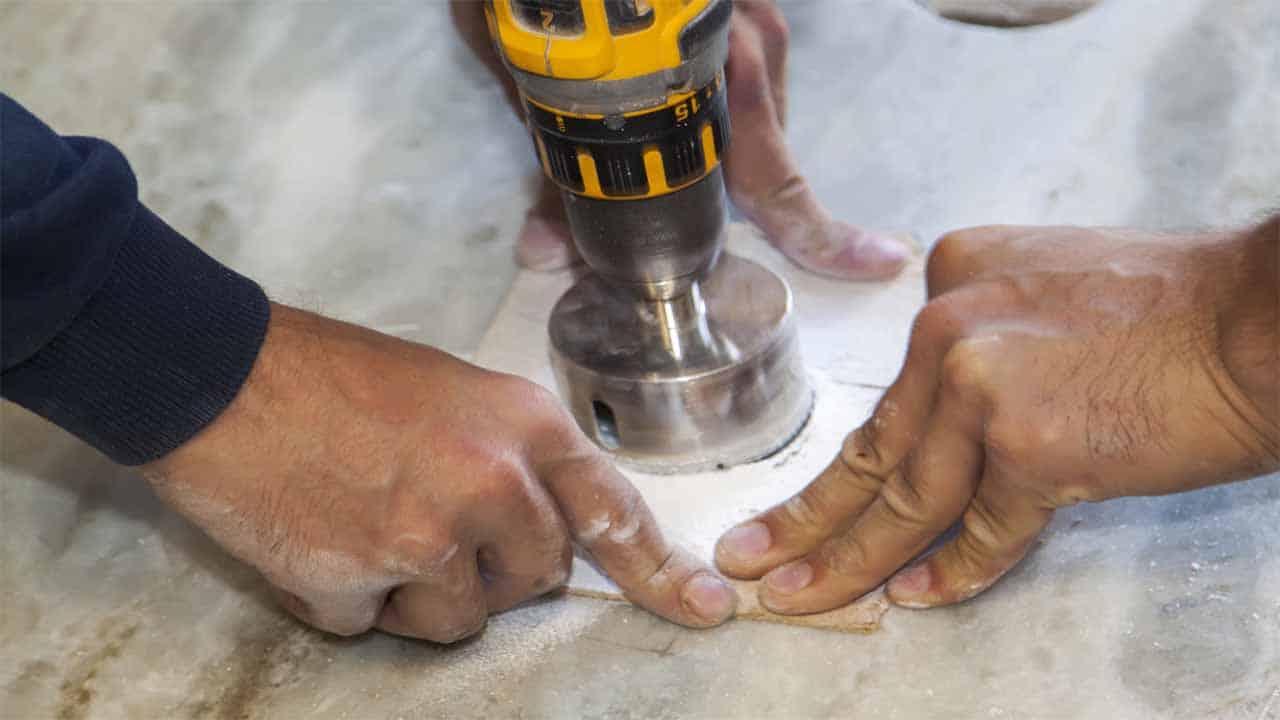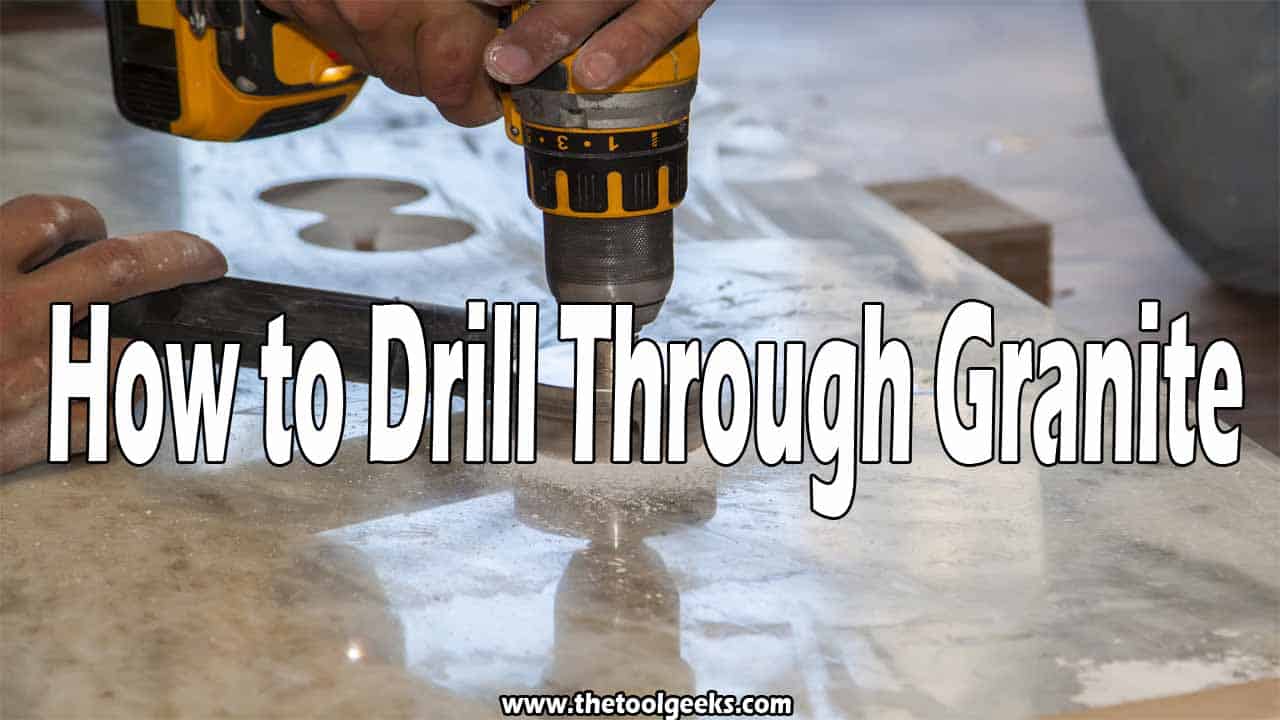How to Drill Through Granite (8 Steps Guide)
TheToolGeeks.com is a participant in the Amazon Services LLC Associates Program and other affiliate advertising programs. We may earn from qualifying purchases. (Learn More).
Granite is a material that is both attractive and durable. This tough and extremely strong natural stone is ideal for countertops. Granite counters are increasingly popular with homeowners, homebuilders, and high-end building projects. They are available in a variety of elegant colors and intricate patterns and finishes. This aesthetic boost makes this an upscale material that is more expensive yet still popular in projects for remodeling or high-end buildings.
Granite is often bought and installed as a single slab covering the entire surface. This means one minor flaw can render the whole purchase useless. The relative brittleness and overall hardness of the material, make granite quite delicate to work with.
It’s recommended to use special saws and industrial-level tools to cut and drill into granite tiles, but it is possible to do it at home. It takes special care and special tools to work with this material, and most importantly, it takes time to penetrate the hard stone safely.
Improper drilling can cause a cracked granite. You don’t want to damage the integrity of the granite, so read on to learn about how to drill through granite.
Jump To Page Contents:
Can You Drill Through Granite?
Yes! It is entirely possible to drill through this natural stone. You’ll want to use the proper handling procedures and power tools to ensure the best quality job.
There’s always a risk of cracking granite while drilling, so be sure to know what to do before jumping into this project. Take your time, be prepared, and be patient. Taking twice as long is better than damaging the granite.
How to Drill Through Granite

Drilling Prep
First and foremost, we need to ensure the work area is safe and secure. Children and pets are often a cause for concern as they can accidentally wander in at the most inopportune times.
It’s best to make sure someone is watching them, so they don’t drive your attention away from the project at hand.
The safety equipment is a must, as there can be loose debris and dust flying out. It might help to have a second pair of hands to aid you with this project.
Check, Recheck, Check Again.
Now that your work area is safe let’s start handling the material. You want to be 150% confident that you need to drill a hole at all. You might need to make a hole for electrical wiring or plumbing, but it’s best to find an alternative if possible. As granite is expensive, there is little room for mistakes, so you’ll want to be sure and consider options.
If you’ve decided that it is necessary, then measure the location of the hole. And then measure it again to be absolutely certain. Note that the granite should be at least one inch away from the wall to keep it from cracking when drilling.
Determine Ideal Hole Size and Mark Area to Drill
It’s good to note that if you’re installing a fixture or a faucet, measure the section that goes through the countertop, not the cover that will sit on top of the granite. Wise words to abide by are, “measure twice, drill once.”
Use a grease pencil to make the mark for smaller holes. Use a small dot when marking a hole with a smaller diameter. For a larger diameter hole, you can draw the exact circle or use a template to accurately match the precise size of the hole you’ll be drilling into the granite.
Related Read — How to Drill Into Epoxy?Clamp Scrap Wood Template and Stone Scrap
You might be worried that while drilling the drill bit may wander. One tip is to place some scrap wood over the granite, and then clamp it securely.
The wood should have a guide hole over the indicated drill target that matches the required size of the hole. Clamping will help ensure that the drill doesn’t slip and won’t be wobbly when it hits granite.
Additionally, you’ll want to prevent chipping underneath the granite. Clamp a piece of stone scrap under the drilling area. Using clamps is safer and more effective, so the drilling motion doesn’t move anything from their designated spot. Secure properly for a good grip.
Install Diamond Drill Bit
You’ll want to use an appropriate drill bit designed for granite that can also handle the drilling application’s depth requirement.
Don’t take risks or chances of ruining the beautiful stone. For instance, a masonry drill bit will not be strong enough to get through the stone. When drilling through granite, it is recommended to use diamond core drill bits.
Securely install the desired size diamond drill bit. Make sure there are no loose attachments as these can be safety hazards.
Begin Drilling
Dip the tip of the drill bit into lubrication. Hold the drill straight with firm pressure. Begin drilling with a steady speed. Don’t force the drill into the granite. Bits cut through stone more cleanly when not forced. Take it slow and easy.
Drill for a couple of seconds through the cap and oil. Raise the bit, so the oil slides into the hole. Drill again for a couple of seconds.
Then raise the bit again and let it cool. Repeat as needed. Most experts recommend about 10 seconds of drilling and 10 seconds of cooling down. It’s good to note that lubricants keep the drill bit cooler, but it is still expected for things to become warm.
Related Read — How to Make a Hole Into Concrete With a Power Drill?Check The Hole
Drill until you’ve gone past granite, through it, and hit the underneath underlying scrap stone. Place a rag under the bottom. Raise the drill, so the oil and residue drain into the rag. If you need to drill multiples holes, then be sure to cool the drill bit with water every time in between holes.
Clean Granite Immediately
Granite is a porous material. It’s vital to clean it right away, so the lubricant doesn’t seep into the pores. Prompt spray the granite with brake cleaner or blow with an air compressor. Wash the slab of granite with detergent and a bristle brush.
Following these steps will prevent the lubricant from soaking into the porous surface and running the material entirely. If you are concerned about this step, then you can stick to using water instead of lubricant.
Tips and Tricks About Drilling a Hole Into Granite
Apply Safety Gear
Put on your eye protection, gloves, earplugs, and mask. Also, be prepared mentally for this time-consuming task. If you are using a helper, they should also be wearing the proper equipment.
Place Bottle Cap Over the Marked Spot Where You Want to Drill
Find a bottle cap that has enough depth, like the cap of a medicine bottle. Place the base of the cap towards the granite, with the opening faced outwards to sit like a cup.
Mold the plumber’s putty around the lid to hold it in place and act as a dam. Mark the point where you want to drill into the center of the bottlecap if needed.
Lubricate The Drill Bits
Some drill bits manufacturers recommend you use water to cool and lubricate their bit while drilling. Others may say their drill bit does not need the extra lubrication to stay cool.
Refer to the notes given with your drill bit. In addition to keeping the drill bit cooler, water or oil will reduce the amount of granite dust in the air. The cap and plumber’s putty will keep the lubricant from leaking into the material around the side.
If you chose not to use lubrication, then you can ask your helper to vacuum the dust as you drill. And you can take more frequent breaks to help the drill bit not overheat.
Spray Top of the Granite With Water
Granite generates a lot of dust; use water to keep it down and prevent it from spreading everywhere. Or have helper spray as you work. A mask will prevent the inhalation of all this dust. You don’t want granite dust in your lungs!
Related Read — Brushed vs Brushless DrillConclusion
Granite is elegant and premium quality material. It’s strong, durable, and beautiful. With proper care and maintenance, it won’t chip and crack. If it is absolutely essential, use these handy skills and techniques to drill into granite like a professional.
Related Read — How to Drill Into a Stud?Amazon and the Amazon logo are trademarks of Amazon.com, Inc, or its affiliates.

